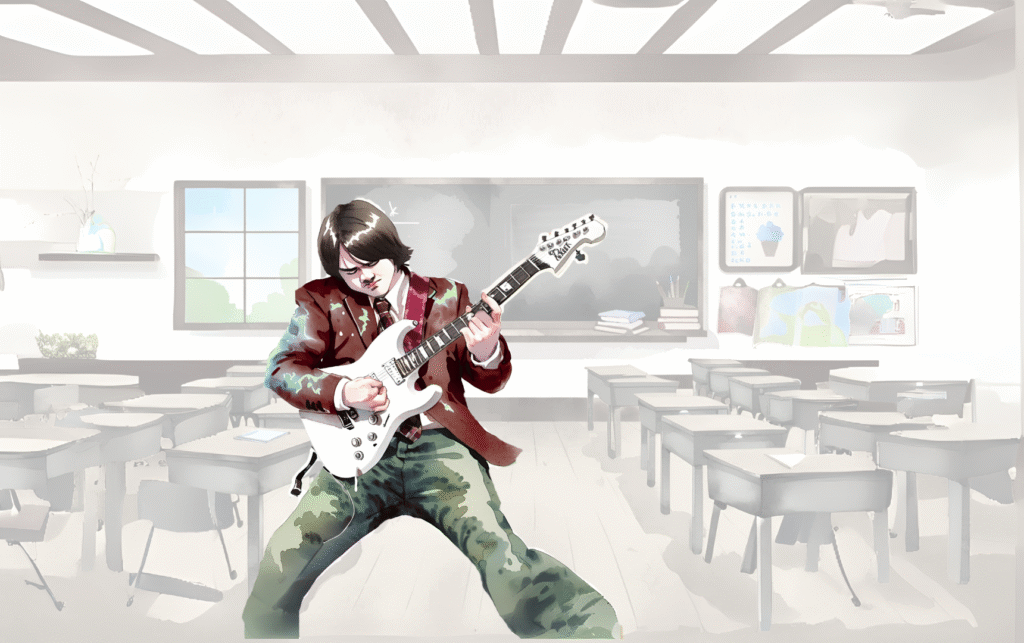
Mystery is one of the most engaging genres for middle school students. The combination of suspense, clues, and unexpected twists captures their imagination and encourages them to think critically as both readers and writers. A creative way to teach students how to craft effective mystery stories is to start with mystery writing activities inspired by film. Movies provide a shared, visual narrative that makes it easier to analyze structure, character motivation, and the placement of clues before moving on to student writing.
Two particularly interesting examples I often turn to are Alfred Hitchcock’s Vertigo (1958) and Rian Johnson’s Knives Out (2019). The first is usually unknown to students because of its age, while the second—though modern—is not among the most famous mysteries, yet it proves to be a truly fascinating one. Both films offer narrative strategies that can be adapted into classroom mystery writing activities.
Using Vertigo: Identity and Hidden Clues
Hitchcock’s Vertigo is more than just a classic thriller—it’s a masterclass in mystery construction. At the heart of the film is a shift in identity: a woman appears to be one person but is, in fact, someone else. This revelation reshapes the entire story and gives students an excellent model of how changing identities can drive a mystery plot.
From Viewing to Writing: a Step-by-Step Approach
-
Watch the film together
Begin with a shared classroom viewing of Alfred Hitchcock’s Vertigo (1958). For many students, this classic will be their first encounter with Hitchcock, so take a few minutes beforehand to explain its context and why it’s a milestone in mystery storytelling. -
Focus on the narrative structure
Guide students to notice how the film’s mystery hinges on a change of identity. Ask them to track:- How Scottie perceives Madeleine at first.
- The turning point where the truth about Judy emerges.
- How this revelation reshapes the story.
-
Analyze key details that lead to the solution
Encourage students to list the visual and narrative clues Hitchcock plants throughout the movie. Which details could they have spotted earlier? Which ones only make sense in hindsight? This exercise trains them to think like detectives. -
Explore the theme of perception vs. reality
Hold a discussion about how appearances deceive and how characters—and viewers—are misled. Connect this to the broader idea of mystery writing: suspense often depends on hiding the truth in plain sight. -
Collaborative mystery writing activity
Invite the class to co-create a mystery short story inspired by Vertigo’s structure:- The protagonist investigates someone with a hidden identity.
- Clues are sprinkled throughout the narrative, some obvious, others subtle.
- The twist comes when the true identity is revealed, changing the meaning of earlier events.
-
Provide sample prompts, for example:
- A new student at school seems perfect, but something in their past doesn’t add up.
- A neighbor is friendly and helpful—yet every time they leave the house, they return looking slightly different.
- The hero falls in love with someone mysterious, only to discover they are not who they claim to be.
This guided approach helps students experience Vertigo not only as a film but also as a model for constructing effective mystery writing activities.
Using Knives Out: The “False Ending”
Rian Johnson’s Knives Out offers a very different kind of narrative experiment: the false ending. The film initially seems to give away the solution, but later twists reframe the story, surprising both the characters and the audience. This technique challenges students to think about how mysteries manipulate expectations and can be an excellent model for mystery writing activities.
From Viewing to Writing: a Step-by-Step Approach
-
Classroom viewing
Watch Rian Johnson’s Knives Out (2019) together with your students. Even though it’s a modern film, many middle schoolers may not be familiar with it. Before starting, explain that it’s an example of a whodunit with a very clever narrative structure. -
Guide observation
Encourage students to pay attention to:- How the story balances suspense with humor.
- The different motives each character might have.
- The way the film introduces twists that shift our perspective.
-
Focus on the “false ending” technique
Without spoiling the film, you can tell students that Knives Out plays with the idea of a resolution that seems final but isn’t. This technique is a powerful tool for young writers: it shows how a story can surprise readers even after they think they know the answer. -
Extend into writing
Challenge students to draft their own mystery short stories where a “false ending” is included: the detective or reader thinks the case is solved, but a hidden layer of truth emerges later. -
Use a ready-to-go resource
To make your life easier, our Knives Out Movie Activities: From Mystery Analysis to Storytelling (Grades 6–8) resource provides everything you need:- Comprehension questions during and after the film.
- Character analysis organizers.
- A worksheet on red herrings.
- Step-by-step graphic organizers for writing an original mystery.
- Peer feedback tools and an answer key.
All of this adds up to about nine hours of structured, no-prep learning, perfect for keeping students engaged while mastering the techniques of suspense, misdirection, and effective storytelling through mystery writing activities.
Why Film Works in Teaching Mystery Writing Activities
By using film, students can:
- Visualize complex narrative structures that are harder to see in text alone.
- Practice critical thinking, identifying clues and predicting outcomes.
- Experiment with writing, trying out identity shifts, false endings, and other mystery techniques in their own stories.
Most importantly, these activities make the process fun and memorable. Students aren’t just analyzing—they’re also creating mysteries of their own, developing both analytical and storytelling skills.
Vertigo and Knives Out are very different films, but together they show students how flexible and surprising mystery writing activities can be. With the right scaffolding—and a mix of teacher-designed and ready-made resources—middle schoolers can become confident detectives and mystery writers themselves.
And what about you? How do you usually use mystery movies in your classroom? Share your experience below!
Happy teaching,
Chiara



